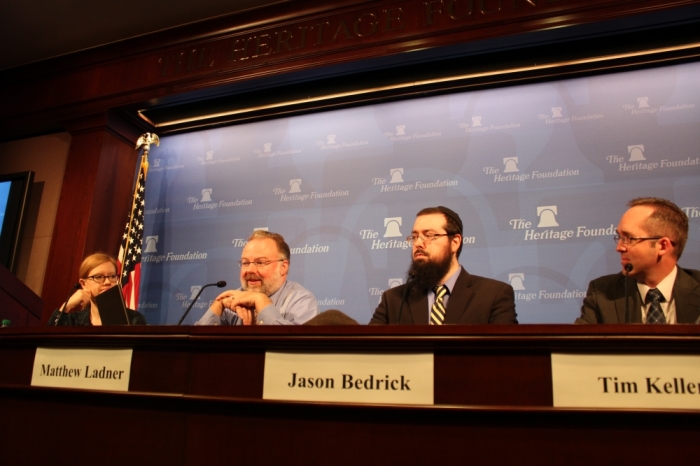Common Core the 'Major Roadblock' to School Choice Innovation That Helps the Poor and Disabled, Experts Say

WASHINGTON — Education experts argued that the Common Core educational standards prove the major obstacle to school choice, a program that could revolutionize K-12 education across the United States, giving parents the best options and giving a hand up to the poor and disabled.
"Now I am going to show you a mythical creature on par with the unicorn and the jackalope — a government program with 100 percent satisfaction," declared Jason Bedrick, a policy analyst for The Cato Institute's Center for Educational Freedom. Bedrick discussed Arizona's Education Savings Accounts (ESA) program, which gives a specific amount of state money to parents for them to use with a variety of educational options. He said such complete satisfaction for a government program is unheard of.
Tim Keller, executive director of the Institute for Justice Arizona Chapter, told the stories of four families whose children benefited from the program. Lexie Weck, for instance, has cerebral palsy, mild mental retardation, and Autism. After the public school refused to send her to a private program, her mother Andrea was able to afford it under the ESA program. "This year, Lexie went rock climbing, she is learning to ride a horse, and she danced with her mom at her mom's wedding," Keller explained.
Education Savings Accounts
Matthew Ladner, senior advisor of Policy and Research at the Foundation for Excellence in Education, explained the Arizona Education Savings Accounts program. "The analogy here is between a rotary telephone and an iPhone." While school voucher programs allow parents to send their kids to multiple schools, ESAs give parents the power to choose from a wide range of education options — from private school, to tutors, to community college courses — even letting them save the extra for college.
"The fact that you can save for future college expenses means that parents are doing the economizing," Ladner explained.
Bedrick pointed out that not every child is eligible for ESAs in Arizona. At first, the program only extended to children with special needs, but it has since been expanded to include kids in failing public schools, adopted children, and military kids.
Helping the Disabled
 3 photos(Photo Credit: The Christian Post/Tyler O'Neil)Tim Keller, executive director of the Institute for Justice Arizona Chapter, speaks about Arizona's Education Savings Accounts at The Heritage Foundation on Friday, January 31, 2014.
3 photos(Photo Credit: The Christian Post/Tyler O'Neil)Tim Keller, executive director of the Institute for Justice Arizona Chapter, speaks about Arizona's Education Savings Accounts at The Heritage Foundation on Friday, January 31, 2014.Since 30 percent who use the program are disabled, Bedrick explained, parents use ESAs for braille and various forms of therapy — speech therapy, swimming therapy, and therapy with horses, which rewires a disabled child's brain so that they can learn to walk.
Keller told the story of Austin Fox, a child with Asperger's Syndrome, who struggled with a 2.0 GPA in a traditional school. The ESA program helped him switch schools. Although he was an atheist, he chose Bios Christian Academy for its student-friendly programs. He ended up scoring in the 90th percentile on the SAT and ACT, and he was offered a full ride to pursue software engineering. Since his parents saved $20,000 in ESAs for college, if he takes the full ride, that money will return to the state.
Helping the Poor
While everyone who used the ESA program was satisfied, it seemed to help the poor the most. "The lowest income families were least satisfied with their previous public school," Bedrick noted, but now they are "the most satisfied with the education savings accounts." 89 percent of poorer families reported that they were "very satisfied," while only 71 percent of the entire group said so.
Bedrick explained that parents have the option to spend more than the ESAs on their children, but most did not outspend the program by much. 24 percent did not spend any more than the ESAs, while 74 percent spent less than $1,000 more. Only 3 percent spent more than $1,000 more than the ESAs offered, and Bedrick said most of them were disabled.
Expanding the Program
"There are several bills this session to expand the program for low to moderate income families," Keller said. He did not comment on the likelihood of the bills passing, but Ladner admitted that "the vast majority of the Arizona public still does not know this program exists."
If the program was larger, Bedrick reported, recipients said they would spend the extra money on educational therapy (70 percent), private tutoring (59 percent), private schools (35 percent), and to save money for college (30 percent).
"We're really just scratching the surface here in Arizona," Ladner declared. If the education system was restructured so that parents had to choose how to educate their children, "you would see a lot more customization, schools catering to parents," and a higher quality education at a lower price.
The Common Core Roadblock
When asked about the biggest obstacle to ESA, Bedrick declared that Common Core was "the big roadblock," because it reverses this dynamic innovation.
"We are on the cusp of revolutionary change where we are going to be able to tailor education to the individual needs of individual children," Bedrick declared. "It doesn't make any sense whatsoever at this point in time to say what we really need to do is have one uniform standard for every child." He admitted that parents make mistakes, but argued "it would be a much bigger mistake to put all kids into one box."





























